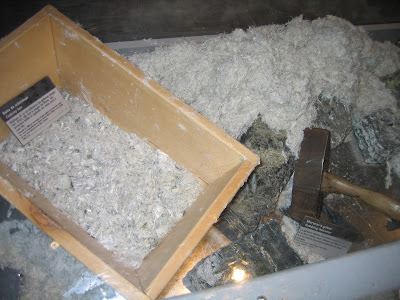On September 16, 2025, Senator Jeff Merkley (D-OR), Representative Suzanne Bonamici (D-OR), and Representative Don Bacon (R-NE) introduced the bipartisan, bicameral Alan Reinstein Ban Asbestos Now (ARBAN) Act of 2025. This long-overdue legislation finally addresses what many of us in the asbestos and environmental industry have been fighting for decades: a complete ban on asbestos in all its forms.
 |
| Asbestos Pipe Insulation Properly Managed |
The bill is named in honor of Alan Reinstein, a passionate advocate for asbestos awareness whose legacy continues through the tireless work of his widow, Linda Reinstein, and the Asbestos Disease Awareness Organization (ADAO). If passed, ARBAN will eliminate all asbestos imports and uses, close the dangerous loopholes left by the Environmental Protection Agency’s (EPA's) 2024 Risk Management for Asbestos, Part 1: Chrysotile Asbestos rule, and ensure that protections are permanent through law - removing the risk of judicial reversal.
 |
| J. Brent Kynoch, Managing Director of EIA |
The Environmental Information Association (EIA), representing professionals across asbestos abatement and environmental remediation (Future Environment Designs, Inc. (FEDTC) is a proud member of EIA), has proudly announced its strong support for ARBAN. J. Brent Kynoch, Managing Director of EIA, stated:
“On behalf of the Environmental Information Association, I express our strong support for the Alan Reinstein Ban Asbestos Now Act of 2025. We greatly appreciate the continuing commitment of Congress to finally ban commercial asbestos—a toxic substance our members have worked tirelessly to help manage and remediate for decades. With the passage of ARBAN, the United States will finally join nearly 70 countries that have already taken decisive action to protect public health.”
For those of us in the industry, the facts remain painfully clear: asbestos exposure has caused generations of suffering, disease, and death. The scientific consensus is undeniable—there is no safe level of asbestos exposure. Yet in 2025, asbestos remains legal in the United States. ARBAN represents the first comprehensive solution that will finally align the U.S. with international public health standards and put an end to preventable asbestos-related tragedies.
 |
| Linda Reinstein of ADAO |
Linda Reinstein, President of ADAO, powerfully reminded us:
“We have known for decades that asbestos causes suffering, disease, and death. It is long past time to end the importation and use of all asbestos in the United States and put a stop to the preventable tragedies that have claimed far too many American lives.”
The legislation has already garnered strong early support from a broad coalition, including ADAO, the American Public Health Association (APHA), Environmental Working Group (EWG), International Association of Fire Fighters (IAFF), Center for Environmental Health (CEH), and EIA, among others. These organizations represent public health advocates, labor unions, scientists, and industry experts who have all witnessed firsthand the devastating impact of asbestos exposure.
ARBAN would:
- Ban all asbestos — including all six recognized fibers, plus winchite and richterite
- Close regulatory loopholes left by EPA’s 2024 rule
- Ensure permanent protections through legislation immune to court reversal
With more than 40,000 Americans dying each year from asbestos-related diseases, the stakes could not be higher. Passing ARBAN is not only about preventing illness and death today - it is about securing a healthier, safer future for workers, families, and communities across the nation.
As someone who has spent their career in the asbestos and industrial hygiene field, we cannot stress enough how critical this legislation is. The United States has delayed for far too long. It is time for Congress to act. 











